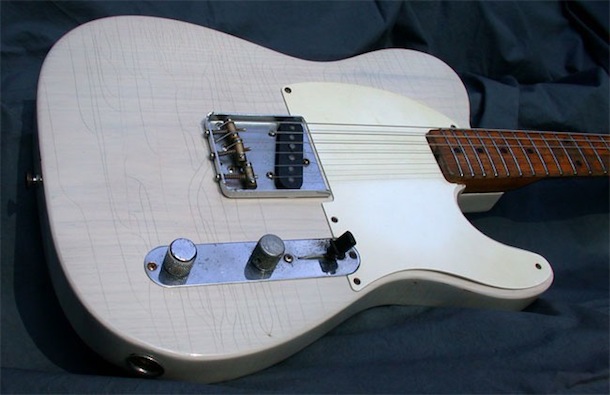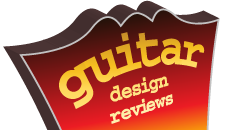The ten principles of guitar design, Part 5, Unobtrusive
This is Part 5 of a 10 part series, applying Dieter Rams’ “10 Principles” to guitar design. Just as we did in previous installments, we should understand that these principles were just one designer’s opinion as to how to evaluate their work, and that they’re presented in their original order assuming that there is no particular importance to that order.
Principle #5:
Good design is unobtrusive
Products fulfilling a purpose are like tools. They are neither decorative objects nor works of art. Their design should therefore be both neutral and restrained, to leave room for the user’s self-expression.
Definition of “Unobtrusive”
This one seems to be pretty simple. According to this Principle, the guitar should be inconspicuous and not attract attention. The player and their music should be the star, not the guitar. The guitar’s primary purpose is to serve as a medium for the player, not the message. Out of all of the 10 Principles, this just might be the least popular among guitarists and guitar designers.
Sometimes it’s hard to remember that not everybody is a guitar player and obsessed with guitars or other music gear. To most people, a guitar might as well be a toaster, and there are a lot more toasters sold around the world than guitars. They’d look at the picture below of Springsteen and see Bruce. The guitar might as well be his favorite pair of well-worn boots. You and I might notice him on our way to admire the Esquire/Telecaster, but even then we’d surmise that he’s the star and the guitar is his really, really nice “toaster”. Now, picture him holding a Gibson Corvus with a custom glitter finish and you have an idea of how a guitar design can draw your attention away from the player.

Counter-intuitive?
This is a point where design philosophies diverge in many directions. Mr. Rams brings us into the world of “Functionalism”, described as:
A belief in or stress on the practical application of a thing, in particular the doctrine that the design of an object should be determined solely by its function, rather than by aesthetic considerations, and that anything practically designed will be inherently beautiful.
The emphasis is on the “practical application” part, which for us is usually the manipulation of the instrument towards musical ends such as practice and performance. We want instruments that play well and sound good to our ears. If we take a Functionalist approach to design, then anything that doesn’t directly relate to the performance characteristics of the guitar is extraneous and should be eliminated. This would include a number of cosmetic design features that are sometimes considered as “traditional” and expected by players.
Binding on an acoustic guitar serves a functional purpose, sealing the end grain on the top and sides and acts like a bumper to resist damage, so that’s a functional design element. Inlaying strips of Abalone shell along the edge as part of the purfling would be considered purely decorative, not functional, and we’d expect a Functionalist designer to refrain from using it. It’s like going to an an Arts and Crafts fair and seeing booth after booth of pottery with paintings of flowers on them. The decoration doesn’t add any functionality to the pieces.

So, if it’s such a great idea to design solely based on functionality, why would we need guitar designers? Couldn’t we just have engineers draw up the plans for us? In my opinion, you can easily spot guitar designs that look like they were conceived by engineers and not Industrial Designers. They get all the functional stuff right, but don’t have the artistic touch to bring all the design elements into a single cohesive whole, and as a result those designs are obtrusive. It shows that Engineers and Industrial Designers need each other.
Our definition of “Functionalism” says that a functional design will be beautiful. Wouldn’t a beautiful guitar be considered to be obtrusive? Would it be considered unobtrusive because it meshes well with the player when we see it in use? What about a design that looks ugly or tacky to us? Which is more obtrusive? Rams’ just says that a good design should be neutral and restrained, at least for the purpose of evaluating it in terms of this Principle, with aesthetics being another Principle altogether.
Other “Practical Applications”
We understand the primary “practical application” for guitars, which is the production of sound in some kind of musical way. There are other applications for guitars that may or may not involve making music, and their required functionality may dictate design elements that would be obtrusive when applied to “normal” guitars.
I imagine that the world’s first musicians were encouraged to integrate visuals into their performance. We’re continuing that grand tradition of showmanship today. Perhaps they integrated decorative design elements into whatever instruments they were playing so that they’d draw attention to them and enhance the audience experience. The same kind of thing is at work in custom, one-off designs such as Prince’s “symbol” guitar or ZZ Top’s fuzzy guitars. They’re definitely obtrusive, but they’re part of their act and they fit within the concept of their performance.

Then there are what we can call “Art” guitars, designed to fulfill a different purpose. Again, these are custom, one-off or limited run pieces that were never intended to be considered as consumer products. For these, the guitar is more canvas than instrument, and there is a deliberate attempt made by the artist to express something. They may or may not sound great or even be playable, but those are secondary considerations for these kinds of guitars. A great example is Martin’s Millionth guitar pictured below, inlayed by the master Larry Robinson.

Then there are those guitars that are designed for marketability, where design elements are manipulated specifically so that they move off the wall hangers in the store faster or can command a higher price tag. Their “practical application” is putting more money in one or more bank accounts and boosting the sales numbers for this month/quarter/year. To do that, they may be designed so that they stand out when displayed next to other guitars, feature minor or major variations on previous popular designs, etc.
Examples of Unobtrusive Guitars?
If you look at something often enough and over a long period of time, nothing looks obtrusive anymore. You just get used to seeing them and they no longer look out of place. It’s hard for us to appreciate how different and potentially obtrusive the solidbody electric guitar looked when it first appeared. You have to appreciate the design work done on those innovative instruments that have become standards.
I don’t know Mr. Rams’ personally, and I’ve never had the opportunity to get his opinion on anything. I have no insight on what he personally considers to be unobtrusive guitar designs. I think, though, we can come up with some examples that are more tools than decorative art, neutral and restrained, and divert attention away to their players.
The Fender Esquire would probably make it on almost everybody’s Top 10 list of unobtrusive guitars. It’s a simple, clean design with a minimum of decorative elements and thoroughly functional. The example below features subdued colors, single ply pickguard, minimal controls fitted with simple knobs, and a practical body style. There’s nothing on this guitar that isn’t designed for functionality. You could make a similar argument for an early Gibson Les Paul Jr.

The Ampeg Dan Armstrong models are also great examples with their Lucite see-through body, minimal fingerboard dots, minimal controls, and simple headstock. It’s as if the designer is making an attempt to ghost the body and let the player show through. The faux-wood pickguard and headstock is something we might deal with in a future installment, though.

A more contemporary example is the Blackbird Guitars “Rider” – a tough, compact, portable design with a good sized air cavity, soundhole, and scale. It’s mission is to play well wherever it may be. It features a monochromatic color scheme, clean lines, and it doesn’t need inlay or wild graphics to look good.

